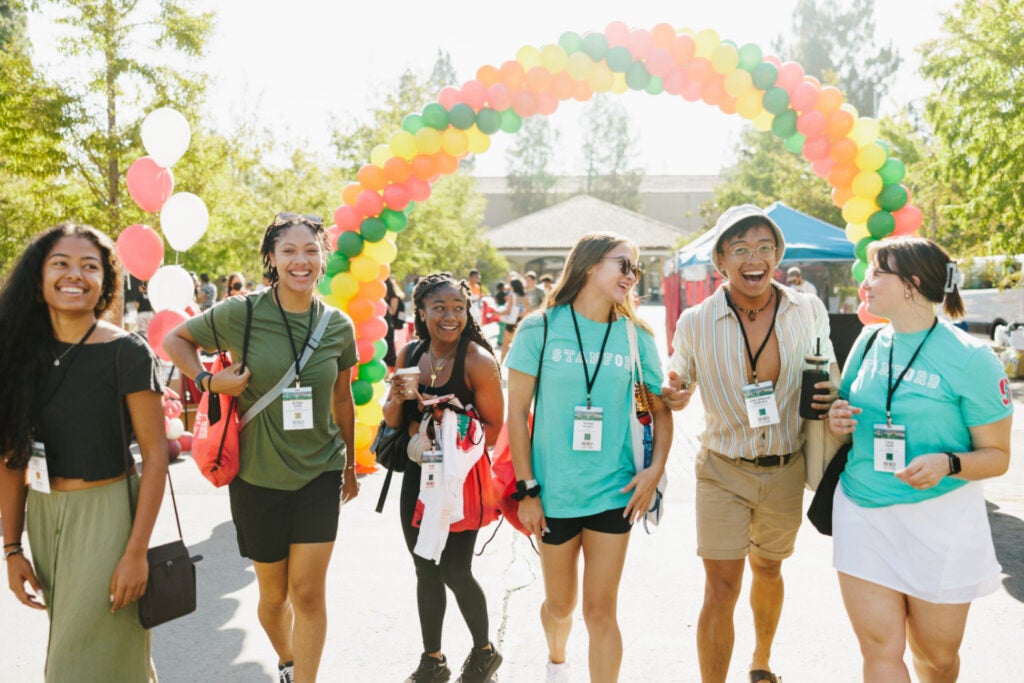Neighborhoods begin the year with new funding, events, and opportunities to get involved
Students can plan gatherings, join community councils, and serve as paid interns, supported by increased staffing and funding for each neighborhood.

Residential student leaders from all neighborhoods attending student staff training, starting with a check-in event held Sept. 6 on White Plaza. (Image credit: Micaela Go)
Stanford’s neighborhoods are starting the 2022-23 academic year with an infusion of funding for community building activities including events and programs, and for new professional staff to support it all. There are also plans to get even more students involved, both as paid interns and in volunteer positions.
The neighborhoods were created in fall 2021 to help students develop rich relationships – both with students across class years and with resident fellows and professional staff – that continue from year to year. Each frosh and transfer is assigned to a neighborhood, which becomes their home throughout their time here.
“We’re centering community,” said Cheryl A. Brown, assistant vice provost for Residential Education. “When you’re moving from your first, to second, to third, to fourth year, you remain in community with people you know and are known by.”
To help students make those connections, each neighborhood holds gatherings throughout the year.
Last year, events included the popular Café Night for Neighborhood D, with artisan coffees and snacks in Ricker Dining Hall on Sunday evenings. Neighborhood D also held movie nights, a Spring Fling dance, and an end-of-year celebration. In Neighborhood N, students flocked to a May the Fourth Star Wars movie night, with Star Wars-themed cookies and some attendees in costume. The neighborhood also chartered buses for up to 250 students to go to Santa Cruz for a day.
Sometimes neighborhoods work together to sponsor campuswide events, as Neighborhoods T and F did last spring to produce Dragfest.
Opportunities to get involved
What activities are on tap for this year? Students will play a key role in shaping plans – as well as in developing the unique culture of each neighborhood.
“The most successful events are ones that are actually dreamed up by students,” said Sydney Osifeso, associate director of administration for Residential Education.
Neighborhood activities are supported by professional staff, and there are a number of ways students can get involved.
Become a neighborhood communications or neighborhood programs intern.
This year, each neighborhood will have two paid student interns: a neighborhood programs intern and a neighborhood communications intern. The programs intern – a new position this year – will work with the professional staff to plan and execute neighborhood events.
Each student communications intern will create flyers for events, post them, and send them via email and Instagram to neighborhood residents. Each neighborhood has its own Instagram account.
These communications positions began last winter, and at first, the goal was simply “getting the word out and convincing people that neighborhoods are more than just a way to restrict where they can live on campus,” said Ameera Waterford, Class of 2024, who was the Neighborhood N communications intern last year.
As communications became more structured, participation increased. Ray Silverman, Class of 2025, communications intern for Neighborhood D last spring, said turnout at neighborhood events increased after the Instagram account and emails were launched. The emails were sent to everyone in the neighborhood, and students followed the Instagram account themselves – with the number of followers for the Neighborhood D Instagram account tripling during spring quarter.
Waterford said that this year, student staff are better informed about how to leverage the funding set aside for neighborhood events, so houses may be able to expand some events to include the entire neighborhood.
“Now that the student staff better know the opportunities, I’m hoping it will be a more active year,” Waterford said.
Join a neighborhood community council.
Each neighborhood has a community council, co-led by professional staff and resident fellows, and including seven to 10 student volunteers – ideally, one from each house. Students can offer input on events and help publicize the events to house residents.
This year, in addition to planning events, the community councils will help pick a tree to represent each neighborhood and generally help to develop the neighborhood identity.
Plan an event.
Not everyone has time to make a long-term commitment to neighborhood work, but students can suggest events to their community council and work with them to plan events.
Talking to their neighborhood professional staff, or to the student who represents their dorm on the community council, is another good way to provide input and find out about opportunities to get involved.
“Knowing who the neighborhood council rep is for your dorm can be a really great way to propose any ideas that you might have – or just ask what’s going on with the neighborhood,” Waterford said.
New professional staff and funding
The neighborhoods launched initially without additional staff in Residential Education, adding to the responsibilities of the student staff and RFs in individual houses. This year, a new Associate Dean of Neighborhood Engagement, four additional Neighborhood Program Directors, and four new Neighborhood Program Coordinators are being added to focus on neighborhood engagement.
Additional funding will also ensure that the neighborhoods can plan regular events: some biweekly, a larger event once a quarter, and occasional all-campus events.
Silverman said he felt a sense of community last year in Neighborhood D.
“You definitely do form bonds,” he said. “I felt like the neighborhood system was a way to help connect with people.”